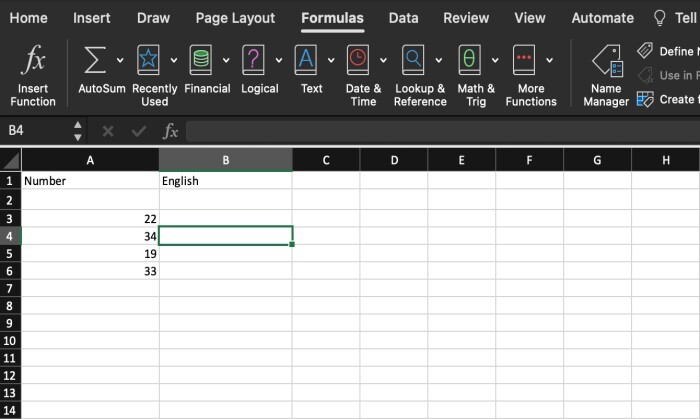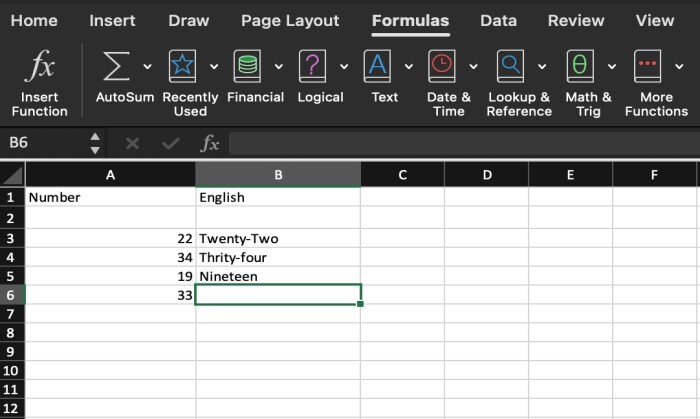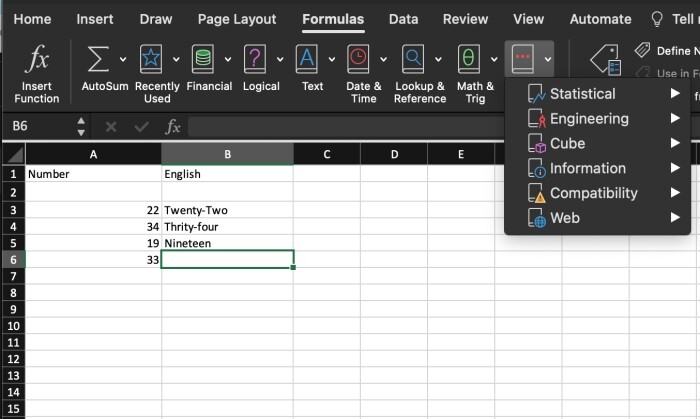
 Data Structure
Data Structure Networking
Networking RDBMS
RDBMS Operating System
Operating System Java
Java MS Excel
MS Excel iOS
iOS HTML
HTML CSS
CSS Android
Android Python
Python C Programming
C Programming C++
C++ C#
C# MongoDB
MongoDB MySQL
MySQL Javascript
Javascript PHP
PHP
- Selected Reading
- UPSC IAS Exams Notes
- Developer's Best Practices
- Questions and Answers
- Effective Resume Writing
- HR Interview Questions
- Computer Glossary
- Who is Who
How to quickly Convert numbers to English words in Excel?
Introduction
When you need to portray numerical data as words in a more legible and appealing style in Excel, converting numbers to English words might be helpful. Financial reports, bills, and other situations where numbers are best comprehended in written form sometimes call for this conversion. Although there isn't a built?in function in Excel for this task, you may complete the conversion by utilizing a unique VBA (Visual Basic for Applications) function. This function can instantly translate numerical numbers into their counterparts in English words.
An overview of Excel's number?to?English?word conversion function is provided below
Visual Basic Editor should be launched. To open the Visual Basic Editor in Excel, press "Alt+F11".
Adding a new module In the Project Explorer panel, right?click the workbook's name and choose "Insert" > "Module." By doing this, you'll establish a new module in which to write VBA code.
Create the custom function: In the module, create a custom VBA function that will translate numbers into words. A pre?existing code may be used, or you can create your own. Online, you may find a variety of samples that you can customize for your purposes.
Once you've finished developing the custom function, save the workbook and exit the Visual Basic Editor.

Using the custom function in Excel is now possible in the same way that you would use a built?in function. Put "=FunctionName(Number)" in a cell, where "FunctionName" is the name of the custom function you wish to use, and "Number" is the number you want to convert.

These methods will show you how to swiftly translate integers into English words in Excel using a custom VBA code. You may convert numerical numbers into a more comprehensible format using the custom function to improve the accessibility and comprehension of your data.
The use of VBA and custom functions in Excel requires some familiarity with programming and the VBA language. To learn more about building custom functions if you're not acquainted with VBA, you may find it beneficial to ask a knowledgeable Excel user for advice or to look for tutorials and online resources.

Why does it happen?
Excel users who want to show numerical data in a more understandable fashion must translate numbers into English words. Although numbers are useful for mathematics and research, they may be challenging to understand quickly. By giving numbers a textual form that is simpler for people to grasp, translating numbers to English words aids in bridging this divide.
As part of the conversion process, an English word is assigned to each digit or group of digits in a number. The number 123, for instance, would become "one hundred twenty?three." Complex numerical numbers may be shown in a more illustrative and understandable fashion in this way.
There are various benefits of changing numerals to English words, including the following
Readability:Using English language to represent numbers improves the readability of data, notably in financial reports, bills, and other situations where it is desired to convey numbers in written form. When providing information with non?technical stakeholders or those who may have trouble understanding numbers, this approach can be quite helpful.
Clarity and comprehension:When dealing with enormous numbers or complicated computations, written words are often simpler to understand and comprehend than numerical figures. The quantity and importance of the results may be better understood by translating numbers to English words, which makes it simpler to read and evaluate data.
Using English language to convey numerical numbers may improve data presentation and communication, making it more understandable to a larger audience. It takes away the reader's need to cognitively translate numerical values into words, lessening the possibility of misunderstanding or confusion.
Compliance and requirements:There may be certain rules or specifications that demand the usage of English terminology for numbers in certain situations or sectors. For standardized reporting or legal compliance requirements, it could be necessary to convert numbers to English words in legal documents, contracts, or financial statements. Although Excel doesn't come with a built?in mechanism for doing this, users may still come up with their own solution by using custom VBA functions. Users are able to create unique routines to translate numerical numbers to their matching English words by using the programming capabilities of VBA.
Conclusion
In conclusion, using Excel to translate numerical data into English words is a useful trick that improves the readability, understanding, and communication of numerical data. Excel does not have a built?in function for this conversion, but the necessary outcome may be obtained by using unique VBA functions.
Numerical values may be made more understandable to a larger audience, especially those who might have trouble with numerical understanding, by being translated into English terms. The textual style makes it easier to read and removes the need for readers to compute numerical values in their minds.
Clarity and understanding are improved when working with enormous numbers or complicated computations, and this is particularly true when converting numbers to English words. Data interpretation and analysis are easier to grasp because of the textual representation's better explanation of the size and importance of the values.
The conversion procedure may be very helpful in financial reports, invoices, and other situations when it is preferable to provide figures in written form. It enhances the way data is presented, making it more attractive and simple to grasp, lowering the likelihood of misunderstanding or confusion.
In certain situations or sectors, it may also be required to translate numbers into English words in order to adhere to particular rules or specifications. English terms are often required in legal papers, contracts, or financial statements for standardized reporting or legal compliance reasons.
While using VBA and custom functions in Excel gives users the ability to design their own conversion solutions, it's crucial to realize that doing so needs some programming experience. To efficiently build and deploy custom VBA functions, users may need to reference internet resources or ask for help from knowledgeable Excel users.
In conclusion, Excel's ability to translate numerical data into English language is an important tool for enhancing the readability, understanding, and communication of numerical data. Users may change numerical information into a more understandable and user?friendly format by using customized VBA procedures, improving data presentation and aiding improved comprehension and interpretation.

